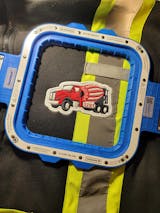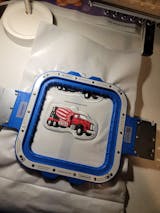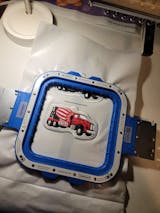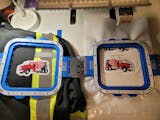1. Introduction to Bobbin Threading Mastery
Ever felt the frustration of tangled threads, skipped stitches, or the dreaded “bird’s nest” under your fabric? You’re not alone. Mastering bobbin threading on Brother sewing and embroidery machines is the secret sauce behind flawless stitches and stress-free sewing. Whether you’re a seasoned embroiderer or just unpacking your first Brother, this guide is your roadmap to precision. We’ll break down step-by-step threading, common troubleshooting, and model-specific tips, arming you with the know-how to tackle any bobbin challenge. Ready to transform confusion into confidence and say goodbye to sewing headaches? Let’s dive into the essentials that will elevate every project, one perfect stitch at a time.
Table of Contents
- 1. Introduction to Bobbin Threading Mastery
- 2. Step-by-Step Bobbin Threading for Brother Machines
- 3. Troubleshooting Common Bobbin Threading Issues
- 4. Model-Specific Threading Guides
- 5. The Critical Role of Proper Bobbin Threading
- 6. Choosing Bobbins and Efficiency Tools
- 7. Advanced Troubleshooting Techniques
- 8. Conclusion: Perfect Stitches Start Here
- 9. FAQs on Brother Bobbin Threading
2. Step-by-Step Bobbin Threading for Brother Machines
Correct bobbin threading is the foundation of every successful sewing project. Brother embroidery sewing machines, with their user-friendly features and thoughtful engineering, make the process straightforward—once you know the right sequence. Follow these steps to ensure your stitches are smooth, your fabric stays protected, and your machine runs like a dream.
2.1 Preparing and Winding the Bobbin Correctly
Start at the top—literally. Place your thread spool on the spool pin and secure it with the appropriate spool cap to prevent slipping. Next, guide the thread through the thread guide and around the bobbin winder thread guide and pre-tension disc. This path is crucial: it ensures the thread winds evenly and with the right tension.
Now, wrap the thread around the bobbin 5-6 times in a clockwise motion. This initial winding anchors the thread and sets you up for success. Slide the bobbin onto the bobbin winder shaft, making sure it’s seated properly. Most modern Brother machines feature a built-in thread cutter—use it to trim the excess thread, keeping things neat and tangle-free.
With the bobbin in place, slide the winder shaft to the right to activate winding mode. Depending on your model, press the start/stop button or use the foot pedal to begin winding. The machine will automatically stop when the bobbin is full, but you can manually stop it if you only need a partial fill. Remove the bobbin and snip the thread. Voilà—your bobbin is wound and ready.
Pro Tip: Always use bobbins recommended for your Brother model. Mixing plastic and metal bobbins can lead to tension issues or even damage your machine.
2.2 Inserting and Threading the Bobbin Case
Now for the magic moment: inserting your bobbin. Raise the presser foot and, if your machine has a lock feature, activate it to prevent accidental starts. Slide the bobbin cover latch to the right and remove the cover.
Drop the bobbin into the case so the thread unwinds to the left—creating that classic “P” shape when viewed from above. This orientation matters; the wrong direction can cause tension problems and poor stitch quality.
Hold the bobbin lightly with your right hand. With your left, guide the thread around the tab of the needle plate cover, then through the slit. This path ensures the thread enters the tension spring, which is vital for smooth, even stitches. Use the built-in cutter to trim the thread. Replace the bobbin cover, making sure the tab fits into the notch, and press down gently to secure.
Model Note: Whether you have a drop-in or front-loading bobbin system, always follow the threading path indicated on your machine. The steps above are model-agnostic best practices, but check your manual for any unique quirks.
2.3 Verification and Safety Protocols
Before you start sewing, it’s time for a quick safety and quality check. Gently pull the bobbin thread—does it move smoothly, with just a bit of resistance? That’s the sweet spot. If it feels stuck or too loose, rethread the bobbin to avoid headaches later.
Reattach the bobbin cover, ensuring everything clicks into place. If your Brother machine features a key lock function, use it during setup to prevent accidental starts. Once you’re ready, unlock the controls and pull both the upper and bobbin threads toward the back and left of the machine. This sets you up for a clean, tangle-free start.
3. Troubleshooting Common Bobbin Threading Issues
Even with careful setup, bobbin problems in brother sewing machine and embroidery can sneak up and sabotage your stitches. The good news? Most issues are fixable with a systematic approach. Here’s how to diagnose and resolve the most common bobbin threading headaches.
3.1 Solving Tension Imbalances and Bird's Nests
If your stitches are loose, puckered, or you spot the infamous “bird’s nest” of tangled thread, tension is likely the culprit. Start by setting your upper thread tension dial to the standard “4” position—this is a reliable baseline for most fabrics.
Next, rethread both the upper and bobbin threads, making sure the threading sequence is spot-on. Use a zigzag stitch on a test fabric; this exposes tension imbalances more clearly than a straight stitch.
For fine-tuning, adjust the bobbin case tension screw in tiny increments—think of the face of a clock, moving the screw by “15 minutes” at a time. Clockwise increases tension; counterclockwise loosens it. Test after each adjustment until your stitches are balanced: upper thread visible on top, bobbin thread on the underside, with their intersection hidden in the fabric’s center.
3.2 Fixing Thread Jams and Needle Breakage
Thread jams and needle breakage can bring your sewing to a screeching halt. Often, the cause is lint buildup, incorrect bobbin seating, or a misaligned tension spring.
First, turn off your machine for safety. Remove the bobbin, needle plate, and carefully clean out any lint or debris with a brush (never use compressed air, as it can push debris deeper). Inspect the bobbin case—ensure it’s fully seated and the notch is properly engaged in the groove.
Check the tension spring and threading guides for wear or damage. If the bobbin case tension screw has loosened over time, gently retighten it. Reassemble and test on scrap fabric.
If problems persist—especially after repeated cleaning and rethreading—it may be time for a professional checkup. Persistent jams or broken needles can indicate deeper mechanical issues that require expert attention.
Ready to conquer your bobbin woes? With these step-by-step instructions and troubleshooting tips, you’re set to enjoy smoother, more reliable sewing—no matter your Brother model.
4. Model-Specific Threading Guides
Not all Brother embroidery and sewing machines are created equal—especially when it comes to bobbin threading. The path your thread takes, the way you insert the bobbin, and even the feel of the process can vary dramatically between models. Let’s break down the unique quirks and best practices for two of Brother’s most popular bobbin-loading systems: front-loading and drop-in.
4.1 Front-Loading Models (LS-2125, CE1100PRW)
Front-loading Brother machines like the LS-2125 and CE1100PRW use a removable bobbin case—a classic design that rewards careful attention to detail.
LS-2125 Series: The Removable Bobbin Case Dance
If you’ve ever found yourself wrestling with a tangle of rings and cases, you’re not alone. The LS-2125 requires you to open the shuttle cover (behind the extension table) to access the bobbin case. Here’s the step-by-step:
- Power Down and Prep: Always turn off your machine and raise the needle to its highest position using the handwheel (turn it counterclockwise).
- Remove the Bobbin Case: Pull the latch toward you to extract the bobbin case from the shuttle race. Avoid removing any additional rings or components—only the bobbin case needs to come out!
- Insert the Bobbin: Unwind about 4 inches (10 cm) of thread from your freshly wound bobbin. Place the bobbin into the case so the thread unwinds in a clockwise direction.
- Thread the Case: Guide the thread into the slot, then down and to the left so it slips under the tension spring and out through the delivery eye.
- Reinstall with Precision: When reinserting, ensure the bobbin case finger fits snugly into the notch at the top of the race. If it’s not seated correctly, the bobbin case will fall out as soon as you start sewing—a frustration many beginners encounter.
- Draw Up the Thread: Hold the upper thread, turn the handwheel, and let the needle grab the bobbin thread, pulling it up through the needle plate.
CE1100PRW: Guided Threading and Built-In Cutter
The CE1100PRW adds a few modern touches to the front-loading experience:
- Access the Compartment: Press the release button to open the bobbin area.
- Bobbin Orientation: Insert the bobbin so the thread pulls off the left side, causing the bobbin to rotate counterclockwise.
- Thread Path: Slip the thread under the half-circle opening and follow the guide path around the compartment. The built-in cutter will trim the thread automatically when threaded correctly.
Pro Tip: Always ensure the bobbin case is fully engaged and the thread is properly under the tension spring. Skipping this step can result in loose stitches or the dreaded “bird’s nest.”
4.2 Drop-In Bobbin Systems (XM2701, XR3774)
Drop-in bobbin systems, featured in models like the XM2701 and XR3774, are beloved for their simplicity and speed—but they come with their own nuances.
XM2701: The Counterclockwise Drop
- Open the Bobbin Cover: Slide back and lift the cover to reveal the bobbin compartment.
- Bobbin Placement: Hold the bobbin so the thread comes off the left side. Drop it in—no fuss!
- Thread the Tension Guide: This is crucial. Guide the thread through the tiny slit in the metal tension guide inside the compartment. If you miss this step, your stitches will suffer.
- Automatic Cutting: Follow the channel to the right. The built-in blade will cut your thread to the perfect length.
- Close Up: Replace the cover, and you’re ready to sew.
XR3774: Standard Winding, Smooth Insertion
- Winding: Place the bobbin on the winder shaft, wrap the thread as directed, and let the machine wind until it stops automatically.
- Insertion: The process mirrors the XM2701—thread off the left, drop in, engage the tension guide, and let the cutter do its job.
Key Takeaway: For all drop-in models, the thread must pass through the tension guide slit. This tiny detail makes all the difference between flawless stitches and frustrating tangles.
Why Model-Specific Matters: Each Brother model has its own threading choreography. Whether you’re working with a removable case or a drop-in system, always consult your manual and follow the threading diagram. A few extra seconds spent here can save hours of troubleshooting later.
5. The Critical Role of Proper Bobbin Threading
You might not see the bobbin thread as you sew, but it’s the silent hero in every stitch. Correct bobbin threading isn’t just a box to check—it’s the foundation for beautiful, reliable results and the long-term health of your machine.
5.1 Stitch Quality and Fabric Protection
Think of the upper and bobbin threads as dance partners—each needs to move in perfect harmony. When bobbin threading is off, the dance stumbles: puckering, loose stitches, or unsightly “bird’s nests” can appear. Proper threading ensures balanced tension, so stitches lock neatly in the fabric’s center, preventing distortion and weak seams.
Why does this matter?
- Prevents Puckering: Even tension distributes pressure across the fabric, keeping it smooth and professional.
- Stops Needle Breaks: Incorrect threading can cause the needle to hit resistance or jam, risking breakage.
- Protects Fabric: Over-tightened or misthreaded bobbins can pull, stretch, or even tear delicate materials.
Analogy Time: Imagine tuning a guitar. Too loose, and the notes are flat; too tight, and the string might snap. The same goes for your bobbin tension—get it just right, and your stitches will sing.
Pro Tip: Use contrasting thread colors in your upper and bobbin threads when testing. It’s an easy way to spot tension problems before they ruin your project.
5.2 Long-Term Machine Health
Proper bobbin threading isn’t just about today’s project—it’s an investment in your machine’s future.
- Reduces Component Wear: Balanced tension minimizes friction on moving parts, extending the life of your machine.
- Prevents Timing Issues: Incorrect threading can throw off the precise timing between the needle and bobbin, leading to skipped stitches or jams.
- Saves on Maintenance: Consistent, correct threading reduces the need for repairs and keeps your machine humming smoothly.
Did you know? Regularly cleaning the bobbin area and using high-quality thread further protects your machine. Lint and poor thread can gum up the works, but a well-threaded bobbin keeps everything running like clockwork.
Bottom Line: Mastering bobbin threading isn’t just about pretty stitches—it’s about preserving your fabric, your sanity, and your sewing machine for the long haul.
6. Choosing Bobbins and Efficiency Tools
The right bobbin and a few clever accessories can make your sewing experience smoother, faster, and more enjoyable. Let’s unravel the options.
6.1 Plastic vs. Metal Bobbins: Brother Compatibility Guide
Brother machines most commonly use Class 15 bobbins—about the size of a nickel, with two flat sides. But not all bobbins are created equal.
Plastic Bobbins:
- Lightweight and transparent—easy to see how much thread remains.
- Designed for most Brother household machines with shuttlehook systems.
- Cost-effective, but pre-wound versions are typically single-use.
Metal Bobbins:
- Heavier and more durable, offering enhanced stability and tension consistency.
- Required for Brother’s PQ series and other professional-grade models.
- Not recommended for machines originally equipped with plastic bobbins, as the extra weight can cause wear.
Compatibility is Key:
Always use the bobbin type specified for your machine. Mixing plastic and metal bobbins—or using generic versions with slightly different dimensions—can throw off tension and even damage your machine.
| Feature | Plastic Bobbin | Metal Bobbin |
|---|---|---|
| Weight | ~1 gram | ~4 grams |
| Visibility | Transparent | Opaque |
| Durability | Lower (replace more often) | Higher (lasts longer) |
| Best For | Most Brother home machines | PQ series, commercial models |
| Cost | Lower | Higher upfront, lasts longer |
Pro Tip:
Never use bobbins from other brands or older machines, even if they look similar. Slight differences in height or width can cause major headaches.
6.2 Accessories for Enhanced Garment Embroidery
Want to take your embroidery to the next level? The right tools can save time, protect your fabric, and boost your results.
Sewtalent Magnetic Hoops:
For garment embroidery, stability is everything. Sewtalent Magnetic Hoops, a type of magnetic hoop for Brother, offer a game-changing solution:
- Lightning-Fast Hooping: Secure fabric up to 90% faster than with traditional hoops—just snap and go.
- Even Tension, No Marks: The magnetic system distributes pressure evenly, minimizing hoop burns and keeping your designs crisp.
- Fabric Protection: Whether you’re working with delicate silks or thick sweatshirts, these hoops hold everything in place without stretching or distorting.
Why it Matters:
A stable hoop means your fabric stays flat, your stitches stay perfect, and you spend less time fiddling with adjustments. Combined with a properly threaded bobbin, you’ll achieve professional-quality results with less effort.
Tension Synchronization:
Proper bobbin threading and the right hooping tool go hand in hand. When your bobbin delivers consistent tension and your fabric is held securely, you unlock the full potential of your Brother machine—no more fighting with skipped stitches or uneven seams.
Ready to Upgrade?
If you’re serious about embroidery, investing in compatible magnetic hoops and sticking to the right bobbin type will pay off in smoother projects, happier fabric, and a machine that lasts for years.
Curious which bobbin or accessory is best for your Brother? Always check your manual, and consider upgrading your hooping system for a faster, frustration-free embroidery experience!
7. Advanced Troubleshooting Techniques
Persistent bobbin issues in embroidery machine Brother can feel like a never-ending puzzle, especially when you’re working with a variety of fabrics. If you’ve mastered the basics but still find yourself battling thread tangles, tension imbalances, or mysterious stitching mishaps, it’s time to level up your troubleshooting game. Let’s dive into advanced diagnostics and fabric-specific solutions that bring clarity—and perfect stitches—back to your sewing.
7.1 Fabric-Specific Solutions
Every fabric has its quirks, and your Brother sewing machine’s bobbin system needs to adapt accordingly. Denim, knits, and delicate fabrics each demand their own tension sweet spot. Here’s how to map out and conquer those challenges:
Denim and Heavy Fabrics: Denim’s thickness and density require a firmer tension balance. Start with a full system reset: remove all threads, clean the bobbin area, and rethread both upper and lower systems. Incrementally tighten the bobbin case screw—think of the face of a clock and move it by “15-minute” intervals—testing on a scrap of denim after each adjustment. Document the upper and lower tension settings that yield even stitches with no puckering or loose loops.
Knits and Stretch Fabrics: Knits are notorious for stretching under tension, which can lead to skipped stitches or “bird’s nests.” Use a lighter touch: slightly loosen the upper and bobbin tensions, and always test on a fabric scrap before starting your project. If you notice loops on the underside, increase the bobbin tension in small increments. Keep a tension chart handy for your favorite knits—record what works for jersey, interlock, and ribbed fabrics.
Delicate Fabrics (Silk, Organza, etc.): Delicates are easily damaged by excessive tension or rough thread paths. Clean your machine meticulously—lint or residue can cause snags that ruin fine fabrics. Use the lightest tension settings that still create balanced stitches, and test with both the upper and bobbin threads. If you see puckering, reduce tension further and consider using a finer needle.
Tension Mapping Chart Example:
| Fabric Type | Upper Tension | Bobbin Tension | Notes |
|---|---|---|---|
| Denim | 4–5 | Slightly Tight | Test after each adjustment |
| Knit (Jersey) | 2–3 | Slightly Loose | Avoid stretching the fabric |
| Silk/Organza | 1–2 | Very Loose | Clean machine before sewing |
Pro Tip: Create your own tension mapping chart for the fabrics you use most. Over time, this will become your secret weapon for flawless results across any project.
7.2 When to Seek Professional Service
Sometimes, even the most diligent troubleshooting can’t resolve persistent bobbin woes. If you notice any of the following, it’s time to call in a pro:
- Timing Mechanism Failures: If your machine consistently fails to pick up the bobbin thread, or you hear irregular clunking noises, the needle-to-hook timing may be off. This is a complex internal adjustment best left to a certified technician.
- Bent or Damaged Components: Frequent needle breakage, visible damage to the bobbin case, or a shuttle race that won’t stay seated are signs of mechanical wear or accidental impact. Attempting DIY repairs can worsen the problem.
- Synchronization Issues: If your stitches are inconsistent despite perfect threading and tension, the synchronization between the upper and lower thread systems may be compromised.
Bottom Line: When advanced cleaning, tension mapping, and systematic rethreading don’t solve the problem, professional servicing ensures your machine stays in top condition—and saves you hours of frustration.
8. Conclusion: Perfect Stitches Start Here
Mastering bobbin threading on your Brother sewing machine is more than a checklist—it’s the foundation for beautiful, reliable sewing. By following model-specific threading steps, fine-tuning your tension, and choosing the right bobbin, you prevent 90% of common sewing issues before they start. Precision in these basics transforms your projects and keeps your machine running smoothly. Ready for flawless stitches, every time? It all begins with the perfect bobbin setup.
9. FAQs on Brother Bobbin Threading
9.1 Q: Why does my bobbin thread keep tangling?
A: In brother sewing machine embroidery, tangling often results from incorrect bobbin orientation, missing the tension spring during threading, or lint buildup in the bobbin area. Always ensure the bobbin unwinds in the correct direction (usually creating a “P” shape), guide the thread through the tension spring, and clean out any accumulated lint for smooth operation.
9.2 Q: Can I use generic bobbins in Brother machines?
A: It’s best to avoid generic bobbins. Even small dimensional differences can disrupt tension and potentially damage your machine. Stick to the bobbin type specified in your Brother manual for optimal performance and to prevent costly repairs.







